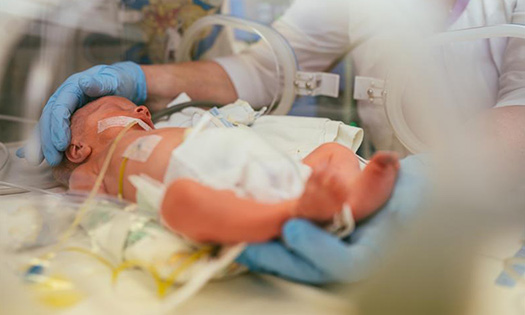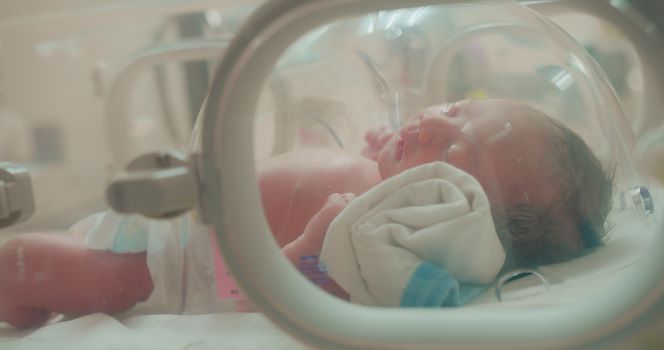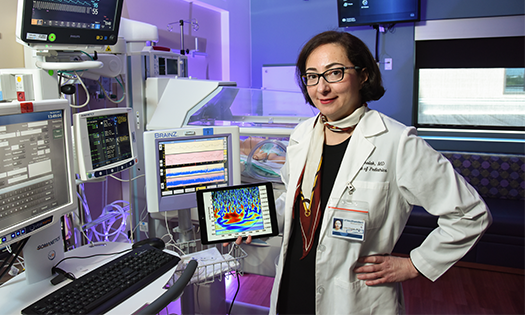Diagnosis and treatment of neonatal hypoxic-ischemic-encephalopathy (HIE) have come a long way in 25 years. Death or disability used to be certain for every child born with the condition. Today, interventions like therapeutic hypothermia mean half of those children make it through the condition unscathed.
But HIE remains one of the most prevalent and severe conditions affecting newborns. That’s why experts like Lina Chalak, M.D., Division Chief of Neonatology at Children's Health℠ and Professor at UT Southwestern, continue to search for new solutions.
Dr. Chalak recently published research showing that newborns with HIE have lower levels of a key anti-inflammatory protein than healthy babies. The study – the first of its kind in newborns with HIE – suggests that inter-alpha inhibitor protein (IAIP) could one day form the basis of new diagnostic tests and treatments. Researchers at Children’s Medical Center Dallas, part of Children’s Health, continue to explore these findings.
Below, Dr. Chalak answers key questions about newly published research and how it might improve HIE care in the future.
Why were you looking at IAIP levels in babies born with HIE?
We have known for years that HIE causes inflammation that harms the baby’s brain. We also know that IAIP is part of the body’s way of fighting inflammation – and that baby mice born with HIE have a deficit of IAIP in their blood.
But we didn’t have a way to study IAIP in human babies until now. We collected the umbilical cord blood for this study 20 years ago and saved it all this time, waiting for the technology to catch up. Finally, the assays necessary to measure serum IAIP levels became available – and we could get the answers we’ve been waiting for.
What were the findings?
The IAIP blood cord concentration in babies born with HIE was one-third lower than the level in healthy babies.
HIE group: median of 278.2 μg/ml (ranging from 138 to 366 μg/ml)
Control group: median of 418.6 μg/ml (ranging from 384.5 to 445 μg/ml)
A difference this large shows that IAIPs are a significant, consistent factor in how HIE manifests in the body – making it a possible biomarker to help us diagnose and treat HIE in the future. Research has identified many other potential biomarkers, but IAIP is special because it does more than signal HIE is present. It also counteracts some of the damaging effects of HIE. So it might also inform future treatments.
How might these findings help diagnose HIE?
They may lead to blood tests that measure IAIP levels and give us more personalized data about each baby and their needs. Currently, diagnosis relies on a clinical neuroassessment of the newborn, which has to be conducted within the first 6 hours of life in order to initiate therapeutic hypothermia in time. But neuroassessing an infant is very difficult and prone to error – it is very dynamic and evolving so a lot can change in those early hours.
An IAIP blood test would supplement the clinical examination, helping providers diagnose HIE with more precision and gauge the need for added therapy. Of course, we need more research to get to that test, including verifying our findings with larger groups and validation cohorts. But our study gets the ball rolling.
What new treatments may be possible?
Someday we may have therapy that replenishes IAIP levels to reduce inflammation and help protect the newborn brain. Currently, hypothermia is the only FDA-approved therapy for HIE — and it doesn’t help every baby. This would give us another tool.
Once again, we need further research, including more clinical trials that investigate whether IAIP-replenishment therapy works. But research has already shown promise in other situations. For example, this type of therapy improved the survival rate of newborn mice with sepsis, another condition that causes a drop in IAIP levels. We hope for similar results in children with HIE.
What other aspects of HIE care are you studying?
We’re testing whether newborns with mild HIE benefit from therapeutic hypothermia. To date, only moderate and severe cases have been tested and found to be eligible for this treatment. At UT Southwestern, I’m leading a large clinical trial, called COOL PRIME, targeting comparative effectiveness of hypothermia for mild HIE which spans 15 sites in the U.S. and one in Ireland.
Our group is also leading an ongoing NIH-funded mechanistic study of possible real-time biomarkers in EEG results. These biomarkers would give us yet another tool to supplement neuroassessment and diagnose HIE with greater precision.
Research like this continues our decades-long fight to move the needle on HIE care and outcomes. I have seen the progress firsthand, in the lives of so many children who thrive despite coming into this world with tremendous risk. Contributing to that progress, while expanding hope to more newborns and families, is the greatest mission and honor of my career.


